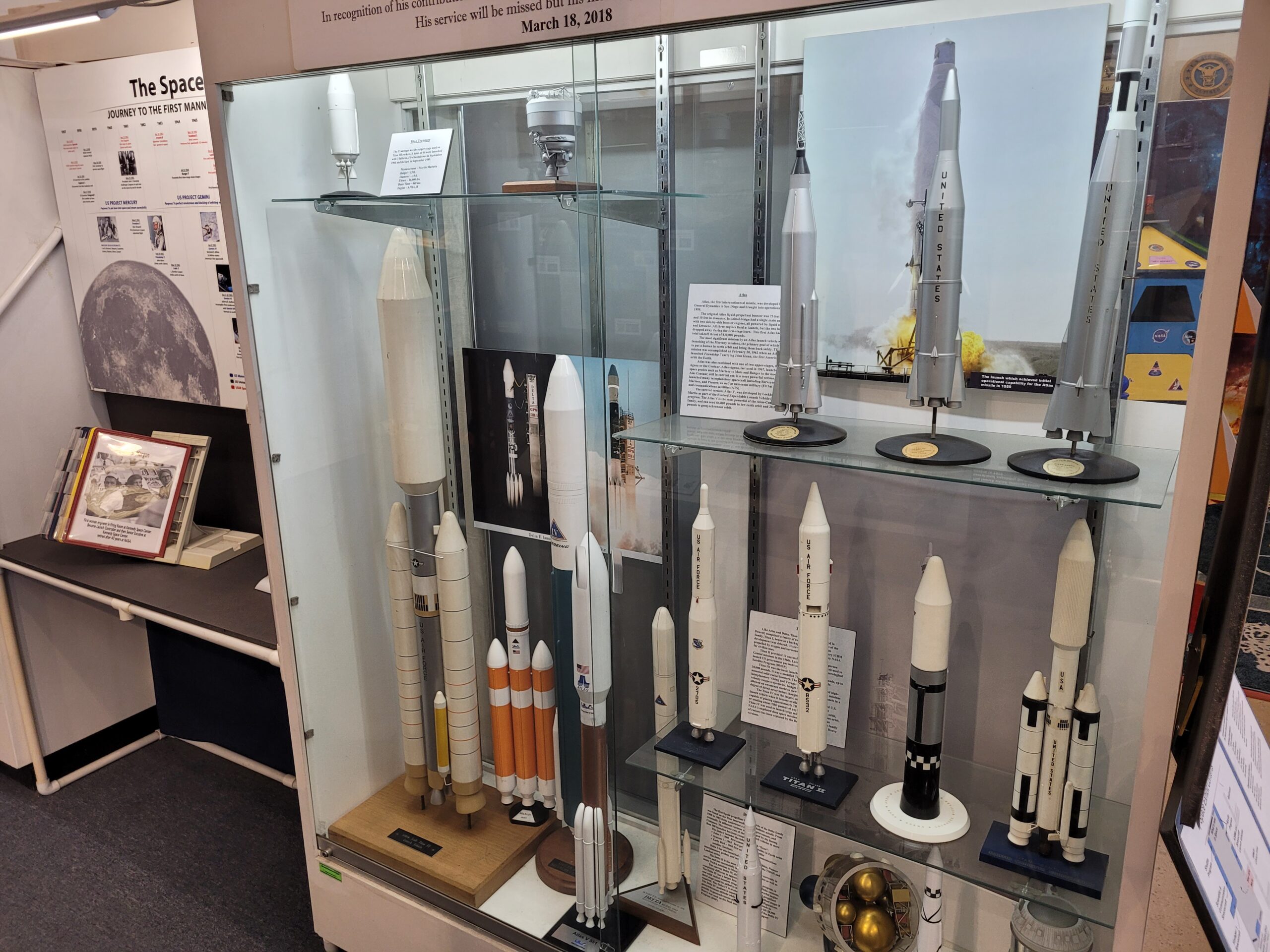Apollo Cabinet
Within the past years, we have celebrated the 50th anniversary of two major milestone of the space program: the first landing of man on the moon, Apollo 11, and the rescue of three astronauts on an aborted mission to the moon, Apollo 13.
To place men on the moon required a very large man-rated rocket. It took six years to design and build the 363-foot tall, three stage Saturn V launch system, weighing 6.5 million pounds at lift off. It is significant to note that nearly two thirds of the companies that were involved in the Apollo program, 172 of them, were located in California.
Launch Vehicle Cabinet
Many of the early space exploration projects used military ballistic missiles as the launch vehicle to achieve escape velocity from earth, about 25,000 mile per hour.
The Mercury project, to place the first US astronaut in orbit around the earth, was the first phase of the Apollo program in the early 1960’s, used the Atlas Intercontinental Ballistic Missile (ICBM), fitted with a single-manned Mercury capsule.
The Gemini Project, placing two astronauts in low earth orbit to demonstrate the rendezvous’ and docking of two spacecraft, was the second phase of the Apollo program to place. A Titan II, second-generation ICBM, was fitted with a two-man capsule, and an Atlas booster with an Agena rocket upper stage was used as the target spacecraft.
As the weight of spacecraft grew, many of the launch vehicles were fitted with additional upper stage rocket boosters as well as strapped-on solid propellant rockets; such as used on Atlas V, Titan III and IV and Delta II and IV.
Shuttle Cabinet
The Space Shuttle Program was NASA’s fourth human spaceflight program with an objective to provide routine transportation for crew and material from Earth to low earth orbit and return. The official designation was Space Transportation System. The first flight was in 1981 and the last in 2011.
Satellite Cabinet
The museum has a display of models of several historic communication and scientific satellites. Most notable of these satellites is the Hubble Space Telescope.
In 1991, the Gamma Ray Observatory (GRO), one of NASA’s Great Observatories, was launched by the Space Shuttle to detect and characterize the high energy photons in the Earth’s orbit,
The Chandra X-ray Observatory, another of NASA’s Great Observatories, has a higher spatial resolution than previous X-ray telescopes and has greatly advanced the field of X-ray astronomy, most notably the detection of a super massive black hole in the center of our own galaxy, Sagittarius A.
During the “Cold War”, the US was concerned about nations launching a preemptive missile strike against the US. In 1970, the Air Force, as part of the Satellite Early Warning System, launched the first of 22 Defense Support Program (DSP) satellites into geosynchronous orbit using a Titan IVB booster with an Inertial Upper Stage.
Voyager 1
A one-tenth scale model of the Voyager 1 spacecraft is on display at the museum. It was launched in 1977 by a Titan III / Centaur to fly by the planets of Saturn and Jupiter to measure the physical properties of the planets and surrounding environment. The satellite is still providing useful data while travelling beyond the influence of the sun and is the furthest man-made object from earth.
Lunar Excursion Module (LEM)
Located on a pedestal above the museum’s normal displays is a one-third scale model of the LEM used in the Apollo Program to land astronauts on the moon, (1961-1972). The unit carried two astronauts. A throttleable descent engine was used to land on the moon while the upper section of the module (with astronauts) was later launched off the moon by a Bell Aerospace rocket into a trans-lunar orbit for rendezvous with the Apollo Command Module to return the astronauts to earth.
U.S. Missile Development Timeline
The USAF Missile Program from 1945 to present, is presented in a storyboard timeline of missile development accentuated with photos of key events and key individuals like Dr. Simon Ramo, Dr. Dean Wooldridge and Gen Bernard Schriever as well as static models of historical missile systems. The static display highlights the key development innovators and explains the breadth of involvement by past and present aerospace corporations in missile development. The video is a tribute to the USAF men and women who stand watch 24/7/365 as a nuclear deterrent to those who would do us harm.




